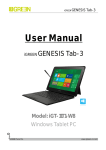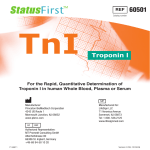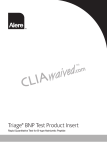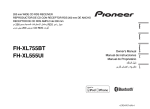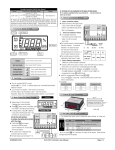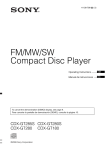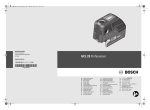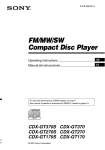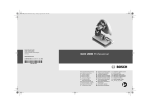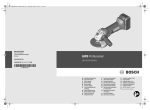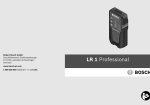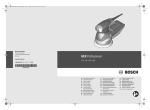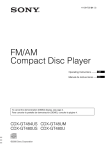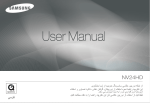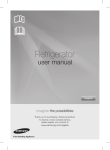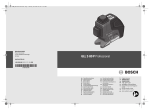Download Obstetrics & Gynecology- Specific PDA: A Resident Gadget
Transcript
Obstetrics & Gynecology- Specific PDA: A Resident Gadget Mechanical adaptor for integrated MIC to reduce noise and focus sound In the Name of God Obstetrics & Gynecology- Specific PDA: A Resident Gadget Mechanical adaptor for integrated MIC to reduce noise and focus sound Mitra Ahmad Soltani MD-MS in Midwifery- MA in TEFL- OBS &GYN resident Azad University- Tehran Medical Branch Tehran-Iran 2008 1 Contents: Dedication------------------------------------------------------------------------------------3 Michigan State University verification------------------------------------------------- 4 Abstract in Farsi ----------------------------------------------------------------------------7 List of tables --------------------------------------------------------------------------------9 List of diagrams-----------------------------------------------------------------------------10 List of pictures ------------------------------------------------------------------------------11 Introductions-----------------------------------------------------------------------------page12 First Application: Fetal heart beat monitoring--------------------------------------page14 FFT, spectrographs, phonocardiography software Mechanical adaptor for an integrated MIC Second Application: Gestational age calculation-----------------------------------page 20 Third Application: Reviews and study guide----------------------------------------page29 Appendix---------------------------------------------------------------------------------page30 References List of actions of a PDA----------------------------------------------------------------page37 RTA program----------------------------------------------------------------------------page39 Abbreviations----------------------------------------------------------------------------page42 Sample History--------------------------------------------------------------------------page43 Excel files--------------------------------------------------------------------------------page44 List of drugs, Drug Prices Data Collection Sheet 2 Power point slides-----------------------------------------------------------------------page46 OBS and GYN exam review OBS and GYN routine orders Decision Making for Common Medical Disorders To my dear Kei, For a better care of ALL MOTHERS 3 4 5 6 ﺑﻪ ﻧﺎم ﺧﺪا ﭼﮑﻴﺪﻩ: ﺑﻪ ﻃﻮر اﺟﻤﺎﻟﯽ اﻳﻦ ﻃﺮح دﺳﺘﮕﺎهﯽ ﺑﺎ اﻧﺪازﻩ ﻳﮏ ﻣﻮﺑﺎﻳﻞ ﺑﺎ ﺻﻔﺤﻪ ﻧﻤﺎﻳﺶ اﺳﺖ ﮐﻪ ﺗﻮﺳﻂ ﺁن ﻣﯽ ﺗﻮان ﺛﺒﺖ ﺿﺮﺑﺎن ﻗﻠﺐ ﺟﻨﻴﻦ ،ﻣﺤﺎﺳﺒﻪ ﺳﻦ ﺑﺎردارﯼ ﺑﺮ ﺣﺴﺐ هﻔﺘﻪ ،ﻣﺮور دروس زﻧﺎن و زاﻳﻤﺎن را ﻋﻼوﻩ ﺑﺮ ﻋﻤﻠﻴﺎت ﻳﮏ ﮐﺎﻣﭙﻴﻮﺗﺮ ﺟﻴﺒﯽ اﻧﺠﺎم داد .هﻤﭽﻨﻴﻦ در اﻳﻦ دﺳﺘﮕﺎﻩ اﻟﮕﻮرﻳﺘﻢ هﺎﯼ ﺗﺼﻤﺼﻴﻢ ﮔﻴﺮﯼ و داروهﺎﯼ ﻣﺼﺮﻓﯽ ﺑﺎ دوز در ﻣﻮرد ﺑﻴﻤﺎرﻳﻬﺎﯼ ﺷﺎﻳﻊ ﻃﺮاﺣﯽ ﺷﺪﻩ اﺳﺖ. -1در ﻣﻮرد ﺳﻤﻊ ﺿﺮﺑﺎن ﻗﻠﺐ ﺟﻨﻴﻦ دو اﺑﺰار در اﻃﺎق زاﻳﻤﺎن وﺟﻮد دارد: اول ﭘﻴﻨﺎرد ﻳﺎ ﮔﻮﺷﯽ ﻣﺎﻣﺎﻳﯽ وﺳﻴﻠﻪ اﻳﯽ اﺳﺖ ﮐﻪ ﺑﺮاﯼ ﺳﻤﻊ ﺻﺪاﯼ ﻗﻠﺐ ﺟﻨﻴﻦ ﺑﮑﺎر ﻣﯽ رود و ﺑﻮاﺳﻄﻪ ﮐﻮﺗﺎﻩ ﺑﻮدن ﻃﻮل ﺁن ،ﺻﻮرت در ﻣﻘﺎﺑﻞ ﻣﺤﻞ ﺁﻟﻮدﻩ و ﺑﺪ ﺑﻮ ﻣﺤﻞ ﺧﺮوج ﺟﻨﻴﻦ ﻗﺮار ﻣﯽ ﮔﻴﺮد. دوم:دﺳﺘﮕﺎﻩ ﺳﻮﻧﻴﮏ اﻳﺪ ) وﺳﻴﻠﻪ ﻧﺴﺒﺘﺎ ﮔﺮاﻧﻘﻴﻤﺖ ﺑﺎ ﮐﺎرﺑﺮد واﺣﺪ( ﮐﻪ داراﯼ ﭘﺮوب اﺳﺖ ﮐﻪ روﯼ ﺷﮑﻢ ﻣﺎدر ﻗﺮار ﻣﯽ ﮔﻴﺮد .در اﻳﻦ دﺳﺘﮕﺎﻩ وﻟﺘﺎژ 220وﻟﺖ ﺑﻪ وﻟﺘﺎژﯼ ﺣﺪود 5وﻟﺖ ﺗﺒﺪﻳﻞ ﺷﺪﻩ و اﻣﻮاج ﺑﺎ ﻓﺮﮐﺎﻧﺲ وراﯼ ﻓﺮﮐﺎﻧﺴﻬﺎﯼ ﺷﻨﻴﺪارﯼ )ﺑﺮاﯼ ﭘﺮوب ﺟﻨﻴﻦ ﺣﺪود 4-3ﻣﮕﺎ هﺮﺗﺰ( ﺑﻪ داﺧﻞ ﻣﺎﻳﻊ ﺁﻣﻨﻴﻮﺗﻴﮏ هﺪاﻳﺖ ﻣﯽ ﺷﻮد و ﺳﭙﺲ ﻃﺒﻖ ﻗﺎﻧﻮن داﭘﻠﺮ ﻣﻮج ﺑﺮﮔﺸﺘﯽ ﺑﺎ ﺗﻐﻴﻴﺮ ﻓﺮﮐﺎﻧﺲ ﺗﻮﺳﻂ هﻤﺎن ﭘﺮوب درﻳﺎﻓﺖ ﺷﺪﻩ و ﺑﺎ ﻓﺮﮐﺎﻧﺲ ﺣﺪود 350هﺮﺗﺰ ﺑﻪ ﺑﻠﻨﺪﮔﻮ ارﺳﺎل ﻣﯽ ﺷﻮد .در ﺑﺨﺶ زاﻳﻤﺎن ﻳﮏ ﻳﺎ دو ﺳﻮﻧﻴﮏ اﻳﺪ وﺟﻮد دارد ﮐﻪ ﮐﻞ ﭘﺮﺳﻨﻞ از ﺁن اﺳﺘﻔﺎدﻩ ﻣﻴﮑﻨﻨﺪ .ﭘﻴﺪا ﮐﺮدن و ﺣﻤﻞ ﺁن ﺳﺨﺖ اﺳﺖ ،ﻧﻴﺎز ﺑﻪ ﻣﺎدﻩ ﻟﻮﺑﺮﻳﮑﺎﻧﺖ دارد و اﻏﻠﺐ اوﻗﺎت ﺑﻮاﺳﻄﻪ ﭘﺎرازﻳﺖ ﻣﺸﮑﻞ ﺳﺎز اﺳﺖ. ﺑﺎ ﻃﺮح اداﭘﺘﻮر ﺗﺒﺪﻳﻞ ﻣﻴﮑﺮوﻓﻮن دروﻧﯽ ﺑﻪ ﻣﻴﮑﺮوﻓﻮن ﺧﺎرﺟﯽ ﻣﯽ ﺗﻮان ﺑﻄﻮر ﻣﮑﺎﻧﻴﮑﯽ ﺻﻮت را ﺗﻮﺳﻂ ﮔﻮﺷﯽ ﭘﺰﺷﮑﯽ ﺑﻪ ﮐﺎﻣﭙﻴﻮﺗﺮ ﺟﻴﺒﯽ وارد ﮐﺮد ﺗﺎ در ﺁﻧﺠﺎ ﺑﺎ ﺑﺮﻧﺎﻣﻪ هﺎﯼ ﮐﺎﻣﭙﻴﻮﺗﺮﯼ ﺻﻮﺗﯽ ﺗﻤﺮﮐﺰ ﺻﻮت و ﺣﺬف اﺻﻮات اﺿﺎﻓﯽ را اﻧﺠﺎم داد .ﮔﻮﺷﯽ ﭘﺰﺷﮑﯽ ﮐﻮﭼﮏ اﺳﺖ و ﻧﻴﺎز ﺑﻪ ﺑﺮق و ﻣﺎدﻩ ﻟﻮﺑﺮﻳﮑﺎﻧﺖ ﻧﺪارد .در ﻧﺘﻴﺠﻪ اﻳﻦ ﮐﺎﻣﭙﻴﻮﺗﺮ ﺟﻴﺒﯽ ﮐﻮﭼﮏ ﻣﻴﺘﻮاﻧﺪ ﻗﺎﺑﻠﻴﺖ ﺗﺸﺪﻳﺪ ﺻﻮت و ﻧﻤﺎﻳﺶ در ﻟﺤﻈﻪ و ﺿﺒﻂ را ﭘﻴﺪا ﮐﻨﺪ. اﻳﻦ اﺑﺰار دﺳﺘﮕﺎﻩ ﮐﻮﭼﮏ ﭼﻨﺪ ﻣﻨﻈﻮرﻩ اﺳﺖ ﮐﻪ در ﺟﻴﺐ ﻗﺎﺑﻞ ﺣﻤﻞ اﺳﺖ و ﺑﺎ ﺑﺎﻃﺮﯼ ﻗﺎﺑﻞ ﺷﺎرژ ﮐﺎر ﻣﯽ ﮐﻨﺪ و از ﺁن ﻋﻼوﻩ ﺑﺮ ﮐﺎرﺑﺮدهﺎﯼ روزﻣﺮﻩ ) ﺿﺒﻂ ﺻﺪا -ﭘﺨﺶ– دﻓﺘﺮ ﺗﻠﻔﻦ -ﮐﺮوﻧﻮﻣﺘﺮ-ﺟﺎﺑﺠﺎ ﮐﺮدن ﻓﺎﻳﻞ ﺑﺎ ﺑﺮﻧﺎﻣﻪ ﺑﻠﻮﺗ ٍﻮٍث( ﻣﯽ ﺗﻮان ﺑﻪ ﺻﻮرت ﺳﻮﻧﻴﮏ اﻳﺪ اﺳﺘﻔﺎدﻩ ﮐﺮد .در ﺿﻤﻦ ﭼﻮن ﺧﺮوﺟﯽ ﺑﻪ ﺻﻮرت ﺗﺼﻮﻳﺮ روﯼ ﻧﻤﺎﻳﺸﮕﺮ ﻇﺎهﺮ ﻣﯽ ﺷﻮد ﭘﺎرازﻳﺖ ﻧﺎﺷﯽ از ﮐﻨﺎر هﻢ ﻗﺮار ﮔﺮﻓﺘﻦ ﻣﻴﮑﺮوﻓﻮن و ﺑﻠﻨﺪ ﮔﻮ ﺑﻮﺟﻮد ﻧﻤﯽ ﺁﻳﺪ. -2ﻣﺤﺎﺳﺒﻪ ﺳﻦ ﺑﺎردارﯼ ﺑﺮ ﺣﺴﺐ هﻔﺘﻪ ﺑﺎ ﺗﻘﻮﻳﻢ اﻳﺮاﻧﯽ ) ﮐﻪ ﻗﺎﺑﻞ ﺗﺒﺪﻳﻞ ﺑﻪ ﺗﻘﻮﻳﻢ ﮔﺮﻳﮕﻮرﻳﺎن هﻢ هﺴﺖ( از ﮐﺎرﺑﺮدهﺎﯼ دﻳﮕﺮ اﻳﻦ دﺳﺘﮕﺎﻩ ﮐﻮﭼﮏ اﺳﺖ. 7 در رﺷﺘﻪ زﻧﺎن و زاﻳﻤﺎن اﺳﺎﺳﯽ ﺗﺮﻳﻦ ﺳﻮاﻻت در ﮔﺮﻓﺘﻦ ﺷﺮح ﺣﺎل ﭘﺮﺳﺶ ﭼﻬﺎر ﺳﻮال زﻳﺮاﺳﺖ: -1ﺳﻦ زن ﺑﺎردار -2دﻓﻌﺎت ﺑﺎردارﯼ ،دﻓﻌﺎت زاﻳﻤﺎن ،دﻓﻌﺎت ﺳﻘﻂ ،ﺗﻌﺪاد ﺑﭽﻪ زﻧﺪﻩ و ﻓﻮت ﺷﺪﻩ -3ﺷﺮوع ﺁﺧﺮﻳﻦ ﻗﺎﻋﺪﮔﯽ -4ﺳﻦ ﺑﺎردارﯼ ﺟﻬﺖ ﻣﺤﺎﺳﺒﻪ ﺳﻦ ﺑﺎردارﯼ ﻓﺎﺻﻠﻪ ﺗﺎرﻳﺦ ﺷﺮوع ﺁﺧﺮﻳﻦ ﻗﺎﻋﺪﮔﯽ را از زﻣﺎن ﺣﺎل ﻣﺤﺎﺳﺒﻪ ﻣﯽ ﮐﻨﻨﺪ .ﻣﺜﻼ اﮔﺮ ﺁﺧﺮﻳﻦ ﻗﺎﻋﺪﮔﯽ ﺗﺎرﻳﺦ 84/11/11ﺑﺎﺷﺪ و ﺧﺎﻧﻢ ﺑﺎردار در ﺗﺎرﻳﺦ 85/5/10ﻣﺮاﺟﻌﻪ ﮐﺮدﻩ ﺑﺎﺷﺪ ﺑﻪ ﻃﻮر ﺳﺮ اﻧﮕﺸﺘﯽ 26هﻔﺘﻪ و 1روز ﻣﺤﺎﺳﺒﻪ ﻣﯽ ﺷﻮد .ﻻزم ﺑﻪ ذﮐﺮ اﺳﺖ ﮐﻪ ﺳﻦ ﺑﺎردارﯼ در ﺣﺮﻓﻪ زﻧﺎن و ﻣﺎﻣﺎﻳﯽ ﺑﺮ ﺣﺴﺐ هﻔﺘﻪ ﺑﻴﺎن ﻣﯽ ﺷﻮد زﻳﺮا وﻗﺎﻳﻊ ﻣﻬﻢ زﻧﺪﮔﯽ ﺟﻨﻴﻨﯽ در هﻔﺘﻪ هﺎﯼ ﺧﺎص ﺑﺎردارﯼ ﺑﺮاﯼ ﺻﺎﺣﺒﺎن ﻓﻦ ﺷﻨﺎﺧﺘﻪ ﺷﺪﻩ اﺳﺖ .ﻣﺜﻼ ﻗﻠﺐ ﺟﻨﻴﻦ از هﻔﺘﻪ 8ﺷﺮوع ﺑﻪ ﻃﭙﺶ ﻣﯽ ﮐﻨﺪ ﻳﺎ اﻳﻨﮑﻪ ﻣﺮگ ﺟﻨﻴﻦ زﻳﺮ هﻔﺘﻪ ﺑﻴﺴﺖ ،ﺳﻘﻂ ﻧﺎم دارد وﻟﯽ ﺑﻌﺪ از ﺑﻴﺴﺖ هﻔﺘﻪ ﻣﺮگ ﺟﻨﻴﻨﯽ ﻧﺎﻣﻴﺪﻩ ﻣﻴﺸﻮد ﻳﺎ ﺁﻧﮑﻪ ﺳﺰارﻳﻦ ﺗﮑﺮارﯼ ﺑﻌﺪ از رﺳﻴﺪﻩ ﺷﺪن رﻳﻪ ﺟﻨﻴﻦ ﺻﻮرت ﻣﯽ ﮔﻴﺮد )ﻳﻌﻨﯽ هﻔﺘﻪ .(38-37 ﻣﺤﺎﺳﺒﻪ ﺳﻦ ﺑﺎردارﯼ از وﻗﺖ ﮔﻴﺮﺗﺮﻳﻦ ﺑﺨﺸﻬﺎﯼ ﮔﺮﻓﺘﻦ ﺷﺮح ﺣﺎل اﺳﺖ و ﺑﻪ هﻤﻴﻦ واﺳﻄﻪ اﺣﺘﻤﺎل ﺧﻄﺎ در اﻳﻦ ﻣﺤﺎﺳﺒﻪ زﻳﺎد اﺳﺖ ،ﺧﻄﺎهﺎﻳﯽ ﮐﻪ ﻣﯽ ﺗﻮاﻧﺪ ﻣﺴﺎﺋﻞ و ﭘﻴﮕﺮدهﺎﯼ ﻗﺎﻧﻮﻧﯽ ﺑﻪ هﻤﺮاﻩ داﺷﺘﻪ ﺑﺎﺷﺪ .ﺑﻪ هﻤﻴﻦ ﺟﻬﺖ روﺷﻬﺎﯼ ﻣﺨﺘﻠﻔﯽ ﺑﺮاﯼ ﺗﺴﻬﻴﻞ اﻳﻦ اﻣﺮﻣﻬﻢ ﻃﺮاﺣﯽ ﺷﺪﻩ اﺳﺖ .ﻧﻤﻮﻧﻪ اﻳﻦ روﺷﻬﺎ ﻗﺎﻧﻮن ﻧﮕﻞ اﺳﺖ ﮐﻪ ﺗﺎرﻳﺦ زاﻳﻤﺎن را ﺑﺎ ﻓﺮﻣﻮل زﻳﺮ ﻣﺤﺎﺳﺒﻪ ﻣﯽ ﮐﻨﺪ:از ﻣﻮرخ ﺷﺮوع ﺁﺧﺮﻳﻦ ﻗﺎﻋﺪﮔﯽ ،ﺳﻪ ﻣﺎﻩ ﮐﻢ و هﻔﺖ روز ﺑﻪ ﺁن اﺿﺎﻓﻪ ﻣﯽ ﮐﻨﻨﺪ .ﻣﺜﻼ در ﻣﻮرد ﻣﺜﺎل ﺑﺎﻻ ﺧﺎﻧﻤﯽ ﮐﻪ ﺁﺧﺮﻳﻦ دورﻩ ﻗﺎﻋﺪﮔﯽ 84/11/11داﺷﺘﻪ ،ﺑﺎﻳﺪ در ﺗﺎرﻳﺦ 85/8/18زاﻳﻤﺎن ﮐﻨﺪ .ﺑﻪ ﺗﺎرﻳﺦ 8/18اﺻﻄﻼﺣﺎ ) EDC (Estimated date of Confinementﻣﯽ ﮔﻮﻳﻨﺪ. هﻤﺎﻧﻄﻮر ﮐﻪ ﻣﺸﺨﺺ اﺳﺖ اﻳﻦ ﻣﺤﺎﺳﺒﻪ ﺳﺎدﻩ ﻧﻤﯽ ﺗﻮاﻧﺪ ﺳﻦ ﺣﺎﻣﻠﮕﯽ را در ﺗﺎرﻳﺦ 85/5/10ﻳﺎ هﺮ زﻣﺎن دﻳﮕﺮ ﺑﺪﺳﺖ ﺑﺪهﺪ. روش دﻳﮕﺮ اﺳﺘﻔﺎدﻩ از ﺗﻘﻮﻳﻢ هﺎﯼ ﻣﺤﺎﺳﺒﻪ زﻣﺎن زاﻳﻤﺎن اﺳﺖ ﮐﻪ ﺁﻧﻬﻢ ﺑﺮاﯼ ﺗﻌﻴﻴﻦ ﺗﺎرﻳﺦ EDCاﺳﺖ. اﺷﮑﺎل ﻣﺤﺎﺳﺒﻪ ﺳﻦ ﺑﺎردارﯼ ﺑﺎ ﻓﺮﻣﻮل ﺁن اﺳﺖ ﮐﻪ ﺷﺶ ﻣﺎﻩ از ﺳﺎل 31روزﻩ اﺳﺖ و ﺷﺶ ﻣﺎﻩ دﻳﮕﺮ 30روزﻩ .ﺑﻌﻼوﻩ اﺳﻔﻨﺪ ﻣﯽ ﺗﻮاﻧﺪ دو ﻣﻘﺪار 30ﻳﺎ 29روز را داﺷﺘﻪ ﺑﺎﺷﺪ و ﺑﺮاﯼ هﻤﻴﻦ اراﺋﻪ ﻳﮏ ﻓﺮﻣﻮل ﺳﺎدﻩ ﺑﺪون" ﺗﺒﺼﺮﻩ" و " اﮔﺮ" اﻣﮑﺎن ﻧﺪارد. در ﮐﺘﺐ ﻣﺎﻣﺎﻳﯽ ﻣﺮﺟﻊ از ﭼﺮﺧﻬﺎﯼ ﻣﺤﺎﺳﺒﻪ ﺣﺎﻣﻠﮕﯽ و ﺗﻘﻮﻳﻢ ﻣﺤﺎﺳﺒﻪ زاﻳﻤﺎن هﻢ ذﮐﺮ ﺑﻪ ﻣﻴﺎن ﺁﻣﺪﻩ ﮐﻪ ﺁﻧﻬﺎ ﻧﻴﺰ ﺑﺎ اﺣﺘﻤﺎل ﺧﻄﺎﯼ ﻳﮏ ﺗﺎ دو روز زﻣﺎن زاﻳﻤﺎن را ) ﺁﻧﻬﻢ ﺑﺮ ﺣﺴﺐ ﻣﺎﻩ ﺗﻘﻮﻳﻤﻬﺎﯼ ﮔﺮﻳﮕﻮرﻳﺎن( ﻣﺤﺎﺳﺒﻪ ﻣﯽ ﮐﻨﻨﺪ ﻧﻪ ﺳﻦ ﺑﺎردارﯼ را. اﻳﻦ دﺳﺘﮕﺎﻩ ﻣﯽ ﺗﻮاﻧﺪ ﺑﺎ دﻗﺖ ±ﻳﮏ روزﻋﻼوﻩ ﺑﺮ ﺻﺮﻓﻪ ﺟﻮﻳﯽ زﻣﺎﻧﯽ ﺑﺮ دﻗﺖ ﻣﺤﺎﺳﺒﻪ ﺳﻦ ﺑﺎردارﯼ ﺑﺮ ﺣﺴﺐ هﻔﺘﻪ ﺑﻴﺎﻓﺰاﻳﺪ ﻗﺎﺑﻞ اﺳﺘﻔﺎدﻩ ﺑﺮاﯼ ﮐﺎرﺑﺮ اﻳﺮاﻧﯽ اﺳﺖ. -3هﻤﭽﻨﻴﻦ از ﻣﺰاﻳﺎﯼ دﻳﮕﺮ اﻳﻦ اﺑﺰار ﮐﻮﭼﮏ اﻣﮑﺎن ﻣﺮورﺧﻼﺻﻪ دروس و ﺗﺴﺘﻬﺎﯼ زﻧﺎن و زاﻳﻤﺎن اﺳﺖ . ﻻزم ﺑﻪ ذﮐﺮ اﺳﺖ ﮐﻪ اﻟﮕﻮرﻳﺘﻢ ﻣﺤﺎﺳﺒﻪ ﺳﻦ ﺑﺎردارﯼ و هﻤﭽﻨﻴﻦ ﺗﻬﻴﻪ اﺳﻼﻳﺪهﺎ و ﺗﺮﺟﻤﻪ و ﺗﺎﻟﻴﻒ ﻣﺘﻮن از ﻓﺎرﺳﯽ ﺑﻪ اﻧﮕﻠﻴﺴﯽ ﺗﻮﺳﻂ اﻳﻨﺠﺎﻧﺐ ﺑﻮدﻩ اﺳﺖ ﮐﻪ در ﺳﺎﻳﺖ داﻧﺸﮑﺪﻩ ﭘﺰﺷﮑﯽ داﻧﺸﮕﺎﻩ ﻣﻴﺸﮕﺎن ﺑﻌﻨﻮان ﻣﻨﺒﻊ ﺑﺮاﯼ داﻧﺸﺠﻮﻳﺎن ﭘﺰﺷﮑﯽ اﻧﮕﻠﻴﺴﯽ زﺑﺎن ﻣﻮرد اﺳﺘﻔﺎدﻩ اﺳﺖ. هﻤﭽﻨﻴﻦ دو اﺑﺰار "ﻣﺤﺎﺳﺒﻪ ﺳﻦ ﺑﺎردارﯼ" و " اداﭘﺘﻮر ﺗﺒﺪﻳﻞ ﻣﻴﮑﺮوﻓﻮن داﺧﻠﯽ ﺑﻪ ﺧﺎرﺟﯽ" ﺑﻌﻨﻮان اﺧﺘﺮاع ﻣﻮﻟﻒ در ادارﻩ ﺛﺒﺖ ﺷﺮﮐﺘﻬﺎ و ﻣﺎﻟﮑﻴﺖ ﺻﻨﻌﺘﯽ ﺑﺎ ﺷﻤﺎرﻩ 38512335و 39571ﺛﺒﺖ ﺷﺪﻩ اﺳﺖ. 8 List of tables Table1- Gestational age in terms of days between any given LMP and date of referral Table2- Gestational age in terms of number of weeks and days between any given LMP and date of referral Table3- list of variables in gestational age calculation 9 List of Diagrams Diagram1: Thinklabs phonocardiography software Diagram2- RTA sample of the sounds picked up by the built-in microphone on the Pocket PC Diagram3: The algorithmic steps of gestational age calculation Diagram 4- Microsoft Excel programmed for OBS and GYN data collections and calculations Diagram 5- Power point slides for review of OBS and GYN texts, questions and orders 10 List of pictures picture1 – integrated MIC on the top of the PDA Picture2- neoprene tube and its grip to fix it on the top of the PDA Picture 3: Stethoscope and neoprene tube functioning as an external microphone Picture 4: The grip Picture5: Gestational age calculation tool 11 Obstetrics and Gynecology Specific PDA: A Resident Gadget Introduction Where is the innovation?! This is a PDA device with its price (350,000 Tomans) and applications. But what is added to it? 1- OBS and GYN orders, texts summaries and exam questions in power point format. The contents are exclusively designed for readability in a PDA. I wrote the slides based on Iran’s OBS and GYN reference books. 2- General medicine decision making algorithms, questions and cases in PPT slides. Again the content is based on Iran’s reference books for Residency Entrance Exam. 3- An innovation about an adaptor to provide an input jack for pocket pc. 4-Programming of Excel files to provide a Data Sheet that can calculate gestational age and BMI. 5-Thinklabs phonocardiography and real time RTA software modified to provide objective visual and saving properties for fetal and maternal heart sounds. Why a PDA is needed for OBS and GYN profession? In a busy OBS& GYN ward it looks quite imperative that a resident be equipped with some tools to facilitate doing her duties. The manifold tasks can consist of: - taking history, -doing physical examinations, - calculating gestational age based on the last menstrual period, -checking fetal heartbeat, - taking notes, -communicating with all members of an OBS and GYN team, 12 And more: - On occasions she needs documented evidence for orders. As residency tasks are done according to ranks, it is probable that a Senior orders a therapy to be implemented by a Junior which later turns out to be out of texts or according to negligence. Introduction of a recording device can reduce the rate of denial and mismanagements accordingly. -Time is an important issue in all surgery wards and OBS and GYN is not an exception. A resident should go through tasks as fast and accurate as the senior resident or attending professor demands. And this all has to be done 100 times a shift. –If not busy by flooding pregnant women inside the maternity hospital, the resident needs to take a look on her notes and exam questions. -On the occasion that she feels her eyes need a rest, she can close them and listen to the morning reports or lectures presented. 13 First application: Introducing an External MIC jack to a PDA with a built-in MIC: Electronic sonic aid has an advantage over traditional Pinards because it can give a fairly objective proof about FHR abnormalities. Yet, it is usually full of noise and its application to have a clear sound of fetal heart beat in the second stage of labor among the woman’s screams and the crowded delivery room is troublesome. Pocket size sonic aids are available commercially with expensive prices in Iran and limited utilities. By real time RTA the sonic aid sent sounds can be traced and counted more easily. By suggested adaptor, the integrated MIC can be changed to an external MIC jack to provide focus and reduce noise. PDA costs half the price of a sonic aid with lots of other utilities. Even an ordinary stethoscope can be heard by a PDA MIC once a neoprene tube is attached to microphone port on the top of a PDA from one end and to a diaphragm of a stethoscope to another end. After pressing the power button on the top of the unit to turn on PDA and fixing the tube by some grips (one is designed here, but any kind of grip or clips is fine) the fetal heart tone or mother’s heart tone can be shown by RTA or recorded. The recorded file can later be viewed and analyzed by Phonocardiography software for Windows. 14 Picture1 – integrated MIC on the top of the PDA The integrated MIC 15 Picture2-neoprene tube and its grip on the top of the PDA The front aspect of the PDA with tube attached 16 The tip of the neoprene tube cut in an oval shape Picture 3: Stethoscope and neoprene tube functioning as an external microphone Picture4: the components of the grip and the rear aspect of the PDA: 17 The head of the grip The beam of the grip The tip of the neoprene tube The beam attachment on the rear aspect of the PDA Diagram1: Thinklabs Phonocardiography Freeware. Tools include spectral analysis (FFT), tone generation and speech synthesis. 18 Diagram2- RTA Demo Freeware takes one minute sample of the sounds picked up by the built-in microphone on the Pocket PC. It then applies a Fourier Transform to the samples, and obtains their frequency spectrum (for more detailed description see appendix section) 19 Second application: Gestational age calculation: As days of a year are composed of a heterogeneous combinations of numbers (like six months of 31 days, one month of 29 days which is 30 days every 4 years), introducing a simple, straight forward formula is practically impossible. The Obstetrics rule that gestational age should be presented in weeks +days adds to the complexity. The following algorithm is what goes on in an Excel program installed in windows mobiles. Gestational age is calculated in weeks based on Last Menstrual Period date and the date of visit. First we have two dates: 2 LMP: like 85/12/3 Iran’s calendar (which is 2007/Feb/22), and the date the woman comes to clinic like 86/ 4/2. We consider the beginning and the end months, with three months in between. The difference of days is calculated based on table 1. If the number falls in the highlighted zone (yellow numbers), one month is added to the LMP; in this example 85/12/3 would change to 85/1/3. The difference of the days is 29 days. If the number falls in the non-highlighted zones, the month of LMP wouldn’t be changed. 1- The difference of months between LMP and visit is calculated according to table 2. According to the LMP of 85/12/3 (here it changed to 86/1/3) and visit on 86/4/2, the table shows there are 3 months (12 weeks) / plus 3 months of 31 days in between. 2- Now we have 32 days (29+3) and 12 weeks. Going to the column of three (12 weeks), we reach the number 32. Then we read the number on the red-lighted column that is 5w+3d. 3- So the final number of gestational age would be 17w+3d. 4- If the month of 12 is 29 days, the gestational age is 17w+2 d, and if it is 30 days, GA is 17w+3d. Table1- The vertical column is for LMP and the horizontal column is for the day of visit. 1 30 29 28 27 26 25 24 23 22 21 20 19 18 17 16 15 14 13 12 11 10 9 8 7 6 5 4 3 2 29 28 27 26 25 24 23 22 21 20 19 18 17 16 15 14 13 12 11 10 9 8 7 6 5 4 3 2 1 1 0 2 28 27 26 25 24 23 22 21 20 19 18 17 16 15 14 13 12 11 10 9 8 7 6 5 4 3 2 1 0 29 3 27 26 25 24 23 22 21 20 19 18 17 16 15 14 13 12 11 10 9 8 7 6 5 4 3 2 1 0 29 28 4 26 25 24 23 22 21 20 19 18 17 16 15 14 13 12 11 10 9 8 7 6 5 4 3 2 1 0 29 28 27 1 0 29 28 27 26 5 25 24 23 22 21 20 19 18 17 16 15 14 13 12 11 10 9 8 7 6 5 4 3 2 6 24 23 22 21 20 19 18 17 16 15 14 13 12 11 10 9 8 7 6 5 4 3 2 1 0 29 28 27 26 25 7 23 22 21 20 19 18 17 16 15 14 13 12 11 10 9 8 7 6 5 4 3 2 1 0 29 28 27 26 25 24 1 0 29 28 27 26 25 24 23 8 22 21 20 19 18 17 16 15 14 13 12 11 10 9 8 7 6 5 4 3 2 9 21 20 19 18 17 16 15 14 13 12 11 10 9 8 7 6 5 4 3 2 1 0 29 28 27 26 25 24 23 22 10 20 19 18 17 16 15 14 13 12 11 10 9 8 7 6 5 4 3 2 1 0 29 28 27 26 25 24 23 22 21 11 19 18 17 16 15 14 13 12 11 10 9 8 7 6 5 4 3 2 1 0 29 28 27 26 25 24 23 22 21 20 20 12 18 17 16 15 14 13 12 11 10 9 8 7 6 5 4 3 1 0 29 28 27 26 25 24 23 22 21 20 19 1 0 29 28 27 26 25 24 23 22 21 20 19 18 2 13 17 16 15 14 13 12 11 10 9 8 7 6 5 4 3 2 14 16 15 14 13 12 11 10 9 8 7 6 5 4 3 2 1 0 29 28 27 26 25 24 23 22 21 20 19 18 17 15 15 14 13 12 11 10 9 8 7 6 5 4 3 2 1 0 29 28 27 26 25 24 23 22 21 20 19 18 17 16 1 0 29 28 27 26 25 24 23 22 21 20 19 18 17 16 15 16 14 13 12 11 10 9 8 7 6 5 4 3 2 17 13 12 11 10 9 8 7 6 5 4 3 2 1 0 29 28 27 26 25 24 23 22 21 20 19 18 17 16 15 14 18 12 11 10 9 8 7 6 5 4 3 2 1 0 29 28 27 26 25 24 23 22 21 20 19 18 17 16 15 14 13 19 11 10 9 8 7 6 5 4 3 2 1 0 29 28 27 26 25 24 23 22 21 20 19 18 17 16 15 14 13 12 20 10 9 8 7 6 5 4 3 2 1 0 29 28 27 26 25 24 23 22 21 20 19 18 17 16 15 14 13 12 11 1 0 29 28 27 26 25 24 23 22 21 20 19 18 17 16 15 14 13 12 11 10 21 9 8 7 6 5 4 3 2 22 8 7 6 5 4 3 2 1 0 29 28 27 26 25 24 23 22 21 20 19 18 17 16 15 14 13 12 11 10 9 23 7 6 5 4 3 2 1 0 29 28 27 26 25 24 23 22 21 20 19 18 17 16 15 14 13 12 11 10 9 8 1 0 29 28 27 26 25 24 23 22 21 20 19 18 17 16 15 14 13 12 11 10 9 8 7 24 6 5 4 3 2 25 5 4 3 2 1 0 29 28 27 26 25 24 23 22 21 20 19 18 17 16 15 14 13 12 11 10 9 8 7 6 26 4 3 2 1 0 29 28 27 26 25 24 23 22 21 20 19 18 17 16 15 14 13 12 11 10 9 8 7 6 5 1 0 29 28 27 26 25 24 23 22 21 20 19 18 17 16 15 14 13 12 11 10 9 8 7 6 5 4 27 3 2 28 2 1 0 29 28 27 26 25 24 23 22 21 20 19 18 17 16 15 14 13 12 11 10 9 8 7 6 5 4 3 29 1 0 29 28 27 26 25 24 23 22 21 20 19 18 17 16 15 14 13 12 11 10 9 8 7 6 5 4 3 2 30 0 29 28 27 26 25 24 23 22 21 20 19 18 17 16 15 14 13 12 11 10 9 8 7 6 5 4 3 2 1 Table2-LMP month (high lighted) and Visit month/ number of 31- day months between LMP and Visit LMP Visit/ no of 31-day months between LMP and Visit 1 8/7 5/4 2/1 9/6 6/5 3/2 10/6 7/6 4/3 2 9/6 6/4 3/1 10/5 7/5 4/2 11/5 8/5 5/3 3 10/5 7/4 4/1 11/4 8/4 5/2 12/4 9/4 6/3 4 11/4 8/3 5/1 12/3 9/3 6/2 1/3 10/3 7/3 5 12/3 9/2 6/1 1/2 10/2 7/2 2/3 11/2 8/2 6 1/1 10/1 7/1 2/2 11/1 8/1 3/3 12/1 9/1 7 2/1 11 8 3/2 12 9 4/3 1 10 8 3/2 12 9 4/3 1 10 5/4 2/1 11 9 4/3 1 10 5/4 2/1 11 6/5 3/2 12 10 5/4 2/1 11 6/5 3/2 12 7/6 4/3 1 21 11 6/5 3/2 12 7/6 4/3 1 8/6 5/4 2/1 12 7/6 4/3 1 8/6 5/4 2/1 9/6 6/5 3/2 **** 7(30W) 4(17w) 1(4w) 8(34W) 5(21W) 2(8W) 9(38) 6(25W) 3(12W) 5w+4 39 38 37 37 36 35 35 34 33 5w+3 38 37 36 36 35 34 34 33 32 5w+2 37 36 35 35 34 33 33 32 31 5w+1 36 35 34 34 33 32 32 31 30 5w 35 34 33 33 32 31 31 30 29 4w+6 34 33 32 32 31 30 30 29 28 4w+5 33 32 31 31 30 29 29 28 27 4w+4 32 31 30 30 29 28 28 27 26 4w+3 31 30 29 29 28 27 27 26 25 4w+2 30 29 28 28 27 26 26 25 24 4w+1 29 28 27 27 26 25 25 24 23 4w 28 27 26 26 25 24 24 23 22 3w+6 27 26 25 25 24 23 23 22 21 3w+5 26 25 24 24 23 22 22 21 20 3w+4 25 24 23 23 22 21 21 20 19 3w+3 24 23 22 22 21 20 20 19 18 3w+2 23 22 21 21 20 19 19 18 17 3w+1 22 21 20 20 19 18 18 17 16 3w 21 20 19 19 18 17 17 16 15 2w+6 20 19 18 18 17 16 16 15 14 2w+5 19 18 17 17 16 15 15 14 13 2w+4 18 17 16 16 15 14 14 13 12 2w+3 17 16 15 15 14 13 13 12 11 2w+2 16 15 14 14 13 12 12 11 10 2w+1 15 14 13 13 12 11 11 10 9 2w 14 13 12 12 11 10 10 9 8 1w+6d 13 12 11 11 10 9 9 8 7 1w+5d 12 11 10 10 9 8 8 7 6 1w+4d 11 10 9 9 8 7 7 6 5 1w+3d 10 9 8 8 7 6 6 5 4 1w+2d 9 8 7 7 6 5 5 4 3 1w+1d 8 7 6 6 5 4 4 3 2 1W 7 6 5 5 4 3 3 2 1 6 6 5 4 4 3 2 2 1 3(12w) 5 5 4 3 3 2 1 1 6(25w) 4 4 3 2 2 1 22 2(8w) 9(38w) 3 3 2 2 2 1 1 1 1 1(4w) 1 5(21w) 8(34w) 4(17w) Table3- list of variables E=LMP month (vertical column) N=number of weeks G=number of days added H= number of 31- day months between LMP and Visit E=1 N=30 N=17 N=4 N=34 N=21 N=8 N=38 N=25 N=12 G=0 G=1 G=2 G=2 G=3 G=4 G=4 G=5 G=6 C=8 C=5 C=2 C=9 C=6 C=3 C=10 C=7 C=4 H=7 H=4 H=1 H=6 H=5 H=2 H=6 H=6 H=3 23 E=2 E=3 E=4 E=5 E=6 E=7 C=9 C=6 C=3 C=10 C=7 C=4 C=11 C=8 C=5 H=6 H=4 H=1 H=5 H=5 H=2 H=5 H=5 H=3 C=10 C=7 C=4 C=11 C=8 C=5 C=12 C=9 C=6 H=5 H=4 H=1 H=4 H=4 H=2 H=4 H=5 H=3 C=11 C=8 C=5 C=12 C=9 C=6 C=1 C=10 C=7 H=4 H=3 H=1 H=3 H=3 H=2 H=3 H=3 H=3 C=12 C=9 C=6 C=1 C=10 C=7 C=2 C=11 C=8 H=3 H=2 H=1 H=2 H=2 H=2 H=3 H=2 H=2 C=1 C=10 C=7 C=2 C=11 C=8 C=3 C=12 C=9 H=1 H=1 H=1 H=2 H=1 H=1 H=2 H=1 H=1 C=2 C=11 C=8 C=3 C=12 C=9 C=4 C=1 C=10 C=5 C=2 C=11 H=4 H=1 C=6 C=3 H=5 H=2 C=7 C=4 H=6 H=3 C=8 C=5 C=2 H=6 H=4 H=1 H=1 E=8 C=3 H=2 C=12 C=9 H=2 E=9 C=4 E=11 E=12 C=1 C=10 H=3 C=1 C=10 H=3 E=10 C=4 H=3 C=5 C=2 H=4 H=1 C=6 C=3 H=5 H=2 C=7 C=4 H=6 H=3 C=11 C=12 C=1 C=5 C=2 C=11 H=4 H=1 C=6 C=3 H=5 H=2 C=7 C=4 H=6 H=3 C=8 C=5 C=2 C=9 C=6 C=3 H=6 H=4 H=1 H=6 H=5 H=2 C=12 C=1 Diagram3: The algorithmic steps of gestational age calculation 24 C=12 C=1 K, F, G, H, L, M, N mean: K=F+G+H K⁄7=M+ remainder of K/7 L=(MOD)remainder of K/7 P=M+N Picture5: Gestational age calculation tool. If an electronic device is not available you can use this abacus –like tool to calculate number of weeks and days between two dates based on Persian calendar. 25 It is easy to work as the month of LMP is added by one and is found on the vertical column on the left. The month of referral is defined by color. The crossing of these two columns is the number of weeks and days between LMP and referral months. 26 The number of weeks and days between LMP and referral days is calculated by the wheel shown at the bottom of the board in picture 5. Some software calculates Gestational age for Gregorian calendars. But PDA Excel for mobile program can be programmed to calculate this function. Excel for mobile can facilitate calculations in OBS (Gestational calculations, BodyMass Index) plus providing a tool to collect and record data about patients. Diagram 4- Microsoft Excel programmed for OBS and GYN data collections and calculations 27 Calculator and data collection sheet: To access Excel Mobile, tap : START>PROGRAMS>EXCEL MOBILE. The preprogrammed file will calculate gestational age once the LMP and referral dates are entered into the chart. This also is the case for calculation of BMI. Once the weight and height are typed in related columns BMI is automatically calculated. Third application Reviews: 28 To view power point slides or word doc files, tap START>PROGRAMS> power point or word doc files. Diagram 5- Power point slides for review of OBS and GYN texts, questions and orders 29 Appendix List of references: References for General medicine algorithms: Available at: Michigan State University site: 30 med-ed-online.org/rcurricula/med_decision_making HTN 1-Braunwald Eugene, et al. Harrison's Principles of Internal Medicine. 16th edition. McGrawHill; 2005 2-Bryan Williams et al. British Hypertension Society guidelines for hypertension management 2004 (BHS-IV) BMJ 2004;328:634-640 3-Drug prices. Ministry of health. Iran.2006 4-Iranian Council for Graduate Medical Education. Exam questions. 5-Katzung Bertram G. Pharmacology: Examinatoin & Board Review.7th edition Mcgrawhill. 2005 6- www.emedicine.com/med/topic1106.htm.2006 7-www.surgicalcriticalcare.net/guidelines/ hypertension_management.pdf-2005 S3& S4 Gallop: 1- auscultation.com/Human/Heart/.../ DiastolicGallopRhythm.htm 2- Braunwald Eugene, et al. Harrison's Principles of Internal Medicine. 16th Edition. McGrawHill; 2005 3-Institute for clinical systems improvement (ICSI). Diagnosis and treatment of chest pain and acute coronary syndrome (ACS).Bloomington (MN);2005 oct.77p 4- Iranian Council for Graduate Medical Education. Exam questions. 5-Katzung Bertram G. Pharmacology: Examination & Board Review.7th edition Mcgrawhill. 2005 6-Regional ALS Treatment Protocols and Procedures.EMT-Paramedics,1998 7-www.emedicine.com/med/topic3552.htm.2006 Arrhythmia: 1- Argyle,Bruce.Madscientist Software. Arrhythmia Management.2006 31 2- Braunwald Eugene, et al. Harrison's Principles of Internal Medicine. 16th edition. McGrawHill; 2005 3- Iranian Council for Graduate Medical Education. Exam questions 4-Katzung Bertram G. Pharmacology: Examination & Board Review.7th edition Mcgrawhill. 2005 5- Mattu, Amal. Myths and Pitfalls in Advanced Cardiac Life Support. University of Maryland School of Medicine. www. EMedHome.com.2006 6- Monroe Community College. Rochester. Laddergrams., New York, Updated: May 10, 1999 URL: /depts/pstc/paraldr1.htm 7-Regional ALS Treatment Protocols and Procedures.EMT-Paramedics, 1998 8- Semiautomatic External Defibrillator. www.health.state.ny.us /nysdoh/ems/pdf/ srgpsaed.pdf 9-www.emedicine.com/med/topic3552.htm.2006 10-Yanowitz,Frank..ECG Learning Center.2006 CAD: 1- Braunwald et al . IHD clinical practice guidelines. 2002 2- Braunwald Eugene, et al. Harrison's Principles of Internal Medicine. 16h edition. McGrawHill; 2005 3- Iranian Council for Graduate Medical Education. Exam questions. 4-Katzung Bertram G. Pharmacology: Examination & Board Review.7th edition Mcgrawhill. 2005 5- Laboratory Findings in Heart Disease. Cardiac Enzymes .www.hoslink.com.2006 6-Massel ,David And Klein.,George J. Guidelines & Policies At The London Health Sciences Centre. 2002. www.lhsc.on.ca/uwodoc/pages/policy.htm 7- Drug prices. Ministry of health. Iran.2006 8- Safeer ,Richard S., Lacivita ,Cynthia L. Choosing Drug Therapy for Patients with Hyperlipidemia American Family Physician. Vol. 61/No. 11 (June 1, 2000) 9- Yanowitz, Frank.www.ECG learning center.2006 32 Trauma: 1-Brohi,Karim.Cervical Spine trauma.www.trauma.org.2006 2-Iranian Council for Graduate Medical Education. Exam questions. 3- Massel ,David . Klein George J.. Guidelines & Policies At The London Health Sciences Centre. www.lhsc.on.ca/uwodoc/pages/policy.htm. 2002. 4- Schwartz, et al. Principles of Surgery. 7th edition. McGrawHill; 1999 5- Tanago Emil A, et al. Smith’s General Urology. 16 th edition. McGrawHill; 2004 6- Wilson, IH and Baskett PJF. The Diagnosis and Treatment of Haemorrhagic Shock. Issue 1 Article 4(1992) www.nda.ox.ac.uk/wfsa/html/u01/u01_007.htm 7-Te Toka Tumal.Auckland District Health Board . http://www.adhb.govt.nz /trauma /scenarios/ 2005. 8-www.swsahs.nsw.gov.au/livtrauma/education/handbook/head.asp. 2006 Empirical antibiotic therapy: 1-Anderoli Thomas E, et al. Cecil Essentials of Medicine. 5th edition. W.B.Saunders; 2001 2-Braunwald Eugene, et al. Harrison's Principles of Internal Medicine. 15th edition. McGrawHill; 2001 3-Department of Clinical Microbiology. Empirical Antibiotic Therapy. Western Infirmary Glasgow.2005. www.gla.ac.uk/~aspee001/abrx.htm 4-Iranian Council for Graduate Medical Education. Exam questions. 5- Ministry of Health. Drug Prices. Iran.2006 6-Tanago Emil A, et al. Smith’s General Urology. 16 th edition. McGrawHill; 2004 Altered Mental State: 1- Aminoff Michael J, et al. Clinical Neurology. 5 th edition. McgrawHill; 2002 2-Anderoli Thomas E, et al. Cecil Essentials of Medicine. 5th edition. W.B.Saunders; 2001 3-Behrman Richard E, et al. Nelson Essential of Pediatrics. 4 th edition. W.B.Saunders; 2002 33 4-Braunwald Eugene, et al. Harrison's Principles of Internal Medicine. 15th edition. McGrawHill; 2001 5- Dunn,M J. Breen ,G D. Davenport ,P. and Gray ,A J. Early management of adults with an uncomplicated first generalised seizure . Emergency Medicine Journal 2005;22:237-242. emj.bmjjournals.com/cgi/content/full/22/4/237 6- Ford, Marsha D. Cecil text book of medicine. Acute poisoning.Saunders company.2004. www.merckmedicus.com/ppdocs /us/common/cecils/ chapters/ 106_006.htm 7-Iranian Council for Graduate Medical Education. Exam questions. 8- Pollard AJ, Nadel S, Habibi P, Faust I, Maconochie I, Britto J, Levin M Meningococcal Infection. Department of paediatrics, Imperial College School of Medicine, St Mary's Hospital, London. 1998. adc.bmjjournals.com/cgi/content/full/80/3/290 9-Regional ALS Treatment Protocols and Procedures.EMT-Paramedics,1998 10- www.Nurses Drug handbook.com.Nursing Spectrum.Emergency Medicine Guidekine.stroke treatment guidelines.2006 Respiratory Aid: 1- Abernethy ,David .The Resident Medical Officer's On line Handbook.2004 mentor.wnmeds.ac.nz/groups/rmo/asthma/asthma5.html 2- Aminoff Michael J, et al. Clinical Neurology. 5 th edition. McgrawHill; 2002 3-Anderoli Thomas E, et al. Cecil Essentials of Medicine. 5th edition. W.B.Saunders; 2001 4-Behrman Richard E, et al. Nelson Essential of Pediatrics. 4 th edition. W.B.Saunders; 2002 5-Braunwald Eugene, et al. Harrison's Principles of Internal Medicine. 15th edition. McGrawHill; 2001 6- Ford ,Marsha D. Cecil text book of medicine. Acid-Base disorders.Saunders company.2004 www.merckmedicus.com/ ppdocs/us/common/cecils/ chapters/ 106_006.htm 34 7- Hogg, K, Dawson ,D and Mackway-Jones ,K.Outpatient diagnosis of pulmonary embolism: the MIOPED (Manchester Investigation Of Pulmonary Embolism Diagnosis) study .2006. emj.bmjjournals.com/cgi/content/full/23/2/123 8-Iranian Council for Graduate Medical Education. Exam questions. 9-Martin,Lawrance.Pulmonary Physiology in Clinical Practice. 1999 www.lakesidepress.com/pulmonary/books/physiology/chap10a.htm 10-Regional ALS Treatment Protocols and Procedures.EMT-Paramedics,1998 11-The diagnostic protocol. CT, computed tomography; PE, pulmonary embolism.Emergency Medicine Journal 2006;23:123-127; doi:10.1136/emj. 2005.027110 12- www.rnceus.com/abgs/abgmethod.html. ABG interpretation method. 13-www.umary.edu/faculty/rschulte/ABG web page cases.doc 14-www.en.wikipedia.org/wiki/mechanical_ventilation OBS &GYN EXAM QUESTIONS, CASES , NOTES and orders References: Available at: Michigan State University site: med-ed-online.org/rcurricula/med_decision_making/OBS &GYN_ questions ppt /OBS &GYN_ orders ppt 1-Williams Obstetrics / 22nd Edition/ MC. Graw Hill/ 2005 2-Novak’s Gynecology/ 13 th Edition/ Williams and Wilkins/ 2002 3-Clinical Gynecology Endocrinology and Infertility/ 7 th Edition / Williams & Wilkins / 2005 4-TE Linde’s (Operative Gynecology) 9 th Edition / Williams and Wilkins / 2003 5-Iranian Council for Graduate Medical. Education. Promotion and board Exam questions.(2000-2007) Sonic aid, Phonocardiography software and adaptor: 1) Mazzoni D, Brubeck M, Crook J, Johnson V et al, Audacity: A Free, CrossPlatform Digital Audio Editor (Version 1.2.6) See: WWW: http://audacity.sourceforge.net/ 35 2)Brinks N, Gabler A, Moes B, van Geest D. Project Proposal and Feasibility Study of electronic stethoscopes . USA:Calvin College. December 10, 2007 3) Pocket RTA demo version.see: WWW.4pockets.com 4)Summit Doppler Systems,Inc. LifeDop user manual.2008 Gestational age calculation algorithm: 1) Ahmad Soltani M. (2007) gestational age calculation. See: Med-ed-online.org/rcurricula/med_decision_making/gestational_age_calculation.pdf 1- Cunningham G, Gant N, Leveno K, et al. (2005)Williams Obsterics. 22nd Ed New York: Mc Graw Hill. 2- Military Obstetrics and Gynecology. BrooksidePress.(2006) Estimating Gestational age. See: www.brooksidepress.org/.../Pregnancy /estimating_ gestational_age.htm 3- Mittendorf R, Williams M, Berkey C, Cotter P. (1990). The Length of Uncomplicated Human Gestation. Obstetrics & Gynaecology 75(6):929-932 4- Transition to Parenthood. Durham J. (2004) How accurate is your due date see: www.transitiontoparenthood.com/ttp/parented/pregnancy/duedate.htm and www.pregnancy.about.com/library/weekly/aa042197.htm Reference for User’s Guide: 1- WWW.HP.com/go/ipaqchoice. 2005 36 PDA components and functions: English English This illustration depicts the items that come in the box with your HP iPAQ. . Box Contents (1) Removable clip cover (2) HP iPAQ (3) Stylus (4) Getting Started CD with special software 2 HP iPAQ Product Information Guide ENWW English Box Contents (5) 1,200 mAh Li-Ion removable/rechargeable battery (6) HP iPAQ documentation (7) Wired stereo headset1, 2 (8) Mini-USB synchronization cable (9) AC adapter with interchangeable plug3 37 List of actions that can be done by a PDA: 1- Synchronization between PDA and up to two computers or one server so that the latest information is in all locations. 2-Entering Text: - Using Block Recognizer - Using the On-screen Keyboard -Using Letter Recognizer -Using Transcriber 3- Playing music and watch videos 4- Viewing and managing digital photos 5-Windows Media Player 10 Mobile 6-Mobile Office ● Calendar ● Contacts ● Tasks ● Messaging ● Internet Explorer Mobile ● Word Mobile ● Excel Mobile ● PowerPoint Mobile 7-WLAN: ● Accessing the Internet ● Sending and receiving e-mail ● Accessing corporate network information 8-Bluetooth ● Transferring information, such as files, appointments, tasks, and contact cards, between devices that have Bluetooth capabilities. ● Printing data to a Bluetooth-designated printer. ● Once connected to another device or computer using Bluetooth, you can locate and use any of the services available on that device. 38 RTA software adjustment hints: 1-Features 44Khz sampling allowing signals up to 22Khz to be measured. Dual Channel FFT display (PC version only). Definable FFT size and sample frequency (Pocket PC only). Single channel spectrograph Standard ANSI/IEC A and C weighting curves. Automatic noise cancellation. Automatic peak note / frequency and octave display. Narrow band Linear and Logarithmic scalable displays. Octave, 1/3 octave and 1/6 octave displays. SPL (Sound Pressure Level) display. 250x zoom for accurate analysis of narrow band data. Internal Signal Generator Touch screen plotting of nearest point with frequency and decibel readout. Up to 64x averaging and smoothing to help stabilize the display. Peak trace facility for better reading of fluctuating frequencies. Selectable signal decay speeds. Selectable signal gain control. Pause facility freezes the live trace to aid analysis of data, 2-Changing FFT Settings (Pocket PC only) Since the Pocket PC is unable to process data as fast as your desktop PC, you can change various FFT settings in order to give a faster response to our input signal. The thing to remember is that the more data we process the more accurate the results but the slower the display. If you only need to analyze signals up to 4Khz for example you can change the sample frequency to 8Khz which cuts down on the amount of data 39 sampled from our input source. If we only need a rough estimation of frequency then we can start with a small buffer size which again speeds up display response. Pressing the FFT Parameters button on your Pocket PC allows you to input new values for Sample Rate and FFT buffer size (See figure 2). If you change either of these settings you will notice that the resolution and time constant values change accordingly. Specifying a low sample frequency and a small buffer size will provide the fastest update but at the expense of accuracy. 3-Input Gain This option allows fairly course calibration of the input signal. If the input signal is too low to read then you may wish to increase the level by 3db which is equivalent to doubling the input sound level. In Spectrograph mode you may want to decrease the gain in order to prevent unwanted background noise from cluttering the display. You can also use this option in conjunction with the 'Noise Weighing' curve in order to totally eliminate background noise. 4-Spectrograph Display A Spectrograph is a 3D representation of frequency/amplitude over time often used for analyzing speech. Each row of the spectrograph represents the results of an FFT on a block of data read from the microphone, the lowest row being the most recent. The colors represent the amplitude of the frequency at a given point in time. Colors range from BLUE, through CYAN, GREEN and YELLOW to RED being the color representing the loudest amplitude possible. You can halt the display at any time using the PAUSE button. It is also possible to use the cursor keys (touch screen on Pocket PC) to zoom into the spectrograph in order to focus on a frequency range. 40 5-Averaging This function is used to help make the display more stable and easier to read. As a general rule, the more difficult the measurement conditions, the more averaging is required. Note however that increasing the number of averages also causes real-time displays to respond more slowly. If this is a problem then it may be better to increase the Decay time rather than use averaging at all. 6-Decay Time Decay is a setting which refers to how quickly a frequency dies. A large decay time is often useful for measuring a highly fluctuating signal. If the input source contains small bursts of energy then setting a higher 'Decay' time may be more favorable than setting a higher 'Averaging' value. Averaging would have the side effect of diluting a signal that was present in short bursts whereas setting a high Decay time would highlight the peaks. 7-Trace All display modes accept the Spectrograph display a trace when this option is enabled. The trace shows the maximum amplitude over the frequency spectrum for a given period. This can be very handy if the input source has a rapidly fluctuating signal. 8-Pause The Pause feature temporarily freezes the display allowing close inspection of captured data. This is extremely useful when you have a highly fluctuating signal or when you need to take several readings across the frequency spectrum. When in PAUSE mode you can utilize PocketRTA's zoom feature and take readings by clicking the left mouse button on various locations on the graph. Pressing the PAUSE key a second time resumes data capture. 9-Exiting the Program To exit PocketRTA on the Pocket PC press the RECORD button (left hand shoulder button on the IPAQ) or the START button (Center of the direction pad). 41 Abbreviations of data collection sheet: Ab=Abortion BG= Blood Group BMI=Body Mass Index CC= Chief Complaint D=Dead Dil=Dilation Eff=Effacement EFW=Estimated Fetal Weight FHR=Fetal Heart rate FM= Fetal Movement G= Gravida GA= Gestational Age GYN HIX= Gynecologic history Hb=Hemoglobin HEENT= head-eyes-ears-nose-throat IMP=Impression Li=living children LMP=Last Menstrual Period P=Para P=Pulse Rate PE= Physical Examination PI= Present Illness Plt=Platelets Repeat C/S= Repeat Cesarean Section RR= Respiratory Rate T= Temperature UH=Uterine Height US= Ultrasound VB= Vaginal Bleeding WB= Water Bag WBC=White Blood Cells 42 Sample History: In the Name of God Patients name: Date: General: LMP GA by LMP: G P Li D ab Repeat C/S VB Head ache Blurred vision Epigastric pain: menses Infertility hx contraception other Allergy HTN Other Medications Heart dis Surgical history Res dis Last meal Kidney dis T P BP RR BMI HEENT Extremities Lymph nodes Heart Respiration Abdomen dil EFW Hb eff Pelvic size plt station FHR BG &Rh WB UH proteinurea position Age: GA by US: CC: PI: WB FM GYN hX menarch PMH: Bleeding tendency Diabetes Convulsions Previous pregnancies: PE: Other IMP: Plan: 43 WBC












































